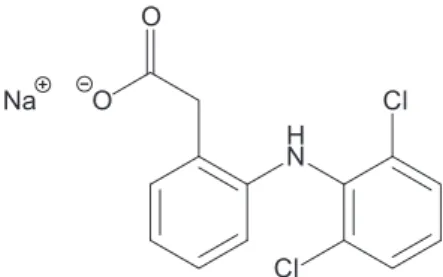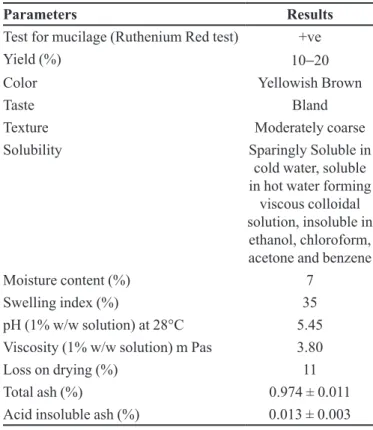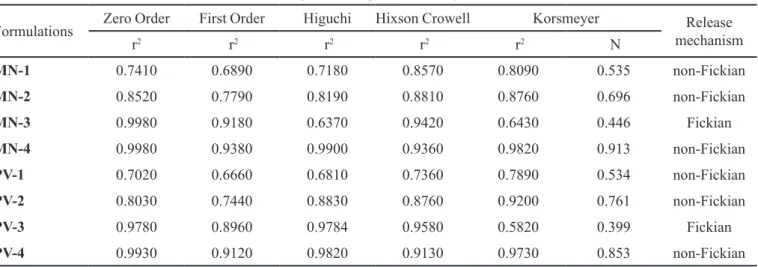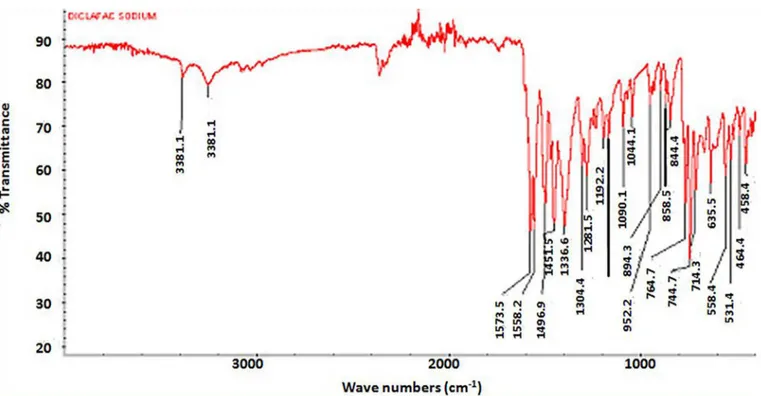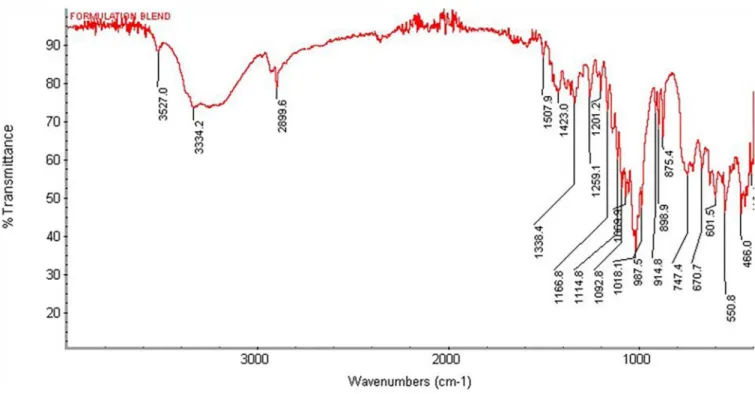*Correspondence: Haroon Rahim. Department of Pharmacy. Sarhad University of Science and Information Technology , Peshawar, Khyber Pakhtunkhwa, Pakistan. E-mail: hrahimpk@gmail.com
A
vol. 52, n. 1, jan./mar., 2016 <http://dx.doi.org/10.1590/S1984-82502016000100022
Isolation and preliminary evaluation of Mulva Neglecta mucilage:
a novel tablet binder
Haroon Rahim
1,*, Abdul Sadiq
2, Shahzeb Khan
2, Kamran Ahmad Chishti
1, Fazli Amin
1,
Mir Azam Khan
2, Sudhair Abbas
11Department of Pharmacy, Sarhad University of Science and Information Technology Peshawar, Khyber Pakhtunkhwa, Pakistan, 2Department of Pharmacy, University of Malakand, Khyber Pakhtunkhwa, Pakistan
The aim of this study was to evaluatebinding potential of Mulva neglecta mucilage (MNM) with subsequent comparison to PVP K30. Eight batches of Diclofenac sodium tablets were prepared bywet
granulation technique keeping diferent concentrations (4, 6, 8 & 10% w/w) of Mulva neglecta mucilage (extracted from leaves of Mulva neglecta) and PVP K30 as standard binder. The granules of formulated
batches showed bulk density (g/mL) 0.49 ± 0.00 to 0.57 ± 0.00, tapped density (g/mL) 0.59 ± 0.01 to 0.70 ± 0.01, Carr’s index 09.27 ± 0.95 to 19.65 ± 0.59, Hausner’s ratio 1.12 ± 0.00 to 1.24 ± 0.01 and angle of repose 30.37 ± 2.90 °C to 36.86 ± 0.94 °C. Tablets were compressed to hardness 7.50 to 7.95 kg/cm2. The tablets showed 0.39 ± 0.02 to 0.39 ± 0.01% friability and 7:20 to 14:00 min disintegration time. Granules and post-compression evaluation revealed that parameters assessed were all found to be within the pharmacopoeial limits. The results (hardness, disintegration and dissolution) proved that Mulva neglecta mucilage has better binding capacity for preparation of uncoated tablet dosage form as
compared to PVP K30. Among all the formulations, MN-1 to MN-4 showed slow release as compared to PV-1 to PV-4 and thereby Mulva neglecta mucilage exhibited satisfactory drug release phenomenon tablets of diclofenac sodium.
Uniterms: Mulva neglecta/mucilage. Mulva neglecta/use as binder. Binders. Diclofenac sodium/tablets/ drug release.
O objetivo deste estudo foi avaliar o potencial de ligação de mucilagem de Mulva neglecta (MNM), com posterior comparação ao PVP K30. Oito lotes de comprimidos de diclofenaco de sódio foram preparados
pela técnica de granulação úmida, mantendo diferentes concentrações (4, 6, 8 e 10% w/w) de mucilagem
de Mulva neglecta (extraída de folhas de Mulva neglecta) e PVP K30 como ligante padrão. Os grânulos
de lotes formulados mostraram densidade aparente (g/mL) 0.49 ± 0.00-0.57 ± 0.00, densidade compactada (g/mL) 0.59 ± 0.01-0.70 ± 0.01, índice de Carr 09.27 ± 0.95-19.65 ± 0.59, a relação de Hausner 1.12 ± 0.00-1.24 ± 0.01 e ângulo de repouso 30.37 ± 2.90 °C a 36.86 ± 0.94 °C. Os comprimidos foram prensados à dureza de 7.50-7.95 kg/cm2. Os comprimidos apresentaram 0.39 ± 0.02-0.39 ± 0.01%
friabilidade e 7:20-14:00 min de tempo de desintegração. A avaliação de grânulos e pós-compressão revelou que todos os parâmetros estavam dentro dos limites da farmacopeia. Os resultados (dureza, desintegração e dissolução) provaram que a mucilagem de Mulva neglecta tem maior capacidade de ligação na preparação da forma de dosagem de comprimido não revestido em relação à PVP K30. Entre
todas as formulações, MN-1 e MN-4 mostraram liberação lenta em comparação com PV-1 e PV-4 e,
assim, a mucilagem de Mulva neglecta exibiu liberação do fármaco satisfatória para os comprimidos de diclofenaco de sódio.
INTRODUCTION
Natural plant drugs and excipients have gained attractiveness over synthetic materials due to their non-toxic nature, free availability and low cost (Zohra et al.,
2012). Mucilages are widely used in pharmaceutical preparations as thickening, disintegrating, binding, suspending, emulsifying, gelling and stabilizing agents (Malviya et al., 2010). Mulva neglecta Wallr.(Mulvaceae),
commonly known as Mallow and locally ‘Sonchal’ in
Mansehra, Pakistan. This is a perennial plant having leaves very shallowly lobed, crenate and pilose (Akcin, Ozbucak
2006; Shah, Khan, 2006). The plant is used as food and to treat acne, broken bones, dermatitis, burns and throat infection (Imtiaz et al., 2012). Diclofenac sodium is a
non-steroidal anti-inlammatory drug (NSAID), which
is poorly soluble in water and freely soluble in organic solvent like methanol. It is commonly used as analgesic,
antipyretic, anti-inlammatory for the long-term treatment of rheumatoid arthritis. Its structure is shown in Figure 1
(Ganesh et al., 2010).
In view of the easy availability of plant, the mucilage from the leaves of the plant was investigated for its use in
tablets formulation and evaluates its eiciency as binder.
MATERIAL AND METHODS
Material
Diclofenac sodium, Avicel pH 101, Aerosil,
magnesium stearate and PVP K30 were provided by Prays
Pharmaceuticals (Pvt) Ltd, Islamabad, Pakistan. Mulva neglecta mucilage was extracted from leaves of plant (Mulva neglecta).
Extraction of the mucilage
Fresh Mulva neglecta plants (10 kg) were purchased
from local market. The plant was identiied by Prof. Dr. Jehandar Shah, Ex-Vice Chancellor, Shaheed Benazir Bhutto University, Sheringal (Dir Upper) Khyber Pakhtunkhwa, Pakistan. The specimen sample (PM-06-12) was kept in Department of Pharmacy, University of Malakand, Chakdara, Dir Lower, Khyber Pakhtunkhwa,
Pakistan. The fresh leaves of the plantwere collected, washed with water to remove dirt and debris, and dried. The powdered leaves were soaked in water for
4-5 h, boiled for 30 min and then kept aside for 1 h for
complete release of the mucilage into water. The material was squeezed, to remove extraneous materials, by straining through a muslin cloth. The mucilage was then precipitated from the solution using absolute acetone.
The precipitate was separated, dried in oven at 50 °C and
stored in tightly closed container for future use in tablets formulations.
Preliminary phytochemical of mucilage
The phytochemical properties for the presence of carbohydrates, proteins, flavonoids, sterols, alkaloids, tannins, saponins, resins, phenols and terpenoids were determined as per standard tests (Cokate, 2010).
Physicochemical characterization
The isolated mucilage was evaluated for solubility in water, acetone, chloroform and ethanol in accordance with
the oicial monograph speciications, swelling index, loss
on drying, total ash and acid-insoluble ash determination (Patel et al., 2012).
Toxicity studies of Mulva neglecta mucilage
Toxicity studies were carried out according to the
method of Knudsen and Curtis. The animals used in the
toxicity studies were sanctioned by the Experimental
protocols were in compliance with “Animals Byelaws 2008 of the University of Malakand”. Ethical Committee
of the Department of Pharmacy, University of Malakand approved the experimental protocols. The male albino rats
of Wistar strain with average weight of 160-200 g were divided into diferent groups comprising of six animals
in each group. The control group received normal saline
20 mL/kg intraperitoneal (i.p). The other groups received 500, 1000, 2000, 3000 and 4000 mg/kg of mucilage
suspension in normal saline orally. The animals were observed continuously for the behavioral changes for the
irst 4 h and then observed for mortality for 48 h (Shah,
Patel, 2010).
Preparation and evaluation of granules
The compositions of tablets are given in Table 4. Diclofenac sodium and Avicel pH 101 were thoroughly
mixed and the solutions of the mucilage and PVP K30 (prepared by dispersing the mucilage and PVP K30 in
water) of diferent concentrations (4, 6, 8 & 10% w/w)
were used for moistening the powder mixture to prepare tablets. The wet mass was then passed through sieve No.
16 and dried at temperature not exceeding 60 °C in hot
air oven up to LOD NMT 5%. The dried granules were
re-sieved through sieve No. 20. The same procedure was
followed for preparation of granules using PVP K30 as binder.
Bulk density
Granules of known weight were poured in 10 ml
graduated cylinder, bulk volume (V0) was noted and
bulk density was calculated (g/cc) by the given formula
(Ganesh, Sureshkumar et al. 2010):
Tapped density
The graduated cylinder (10 ml) containing known
weight of granules was tapped on a hard surface until no further change in volume was observed. The tapped volume (VT) was noted and tapped density was calculated by putting values in formula, Weight of granules/ VT (Ganesh et al., 2010).
Compressibility index
It was determined by Carr’s compressibility index,
by formula:
where Td is tapped density and Bd is bulk density.
Hausner’s ratio
It is the ratio of tapped density to bulk density and was calculated by the following formula (Chakraverty,
2011):
where Td is tapped and Bd is bulk density.
Angle of repose (°)
It was determined by filling 10 g of powder in a
funnel. Then the funnel was opened to release the powder on the paper to form a conical heap. The values were calculated by the given formula (Chakraverty, 2011).
Compression of Granules/ Preparation of tablets
The granules were then into tablets using rotary
machine (ZP19 Rotary Tablet Press, Shanghai, China).
Evaluation of tablets
Thickness
The thickness of a tablet can vary without any
change in its weight. This is generally due to the diference
of density of granules, pressure applied for compression and the speed of compression. The thickness of the tablets
was determined by using a Digital Caliper (Shingala et al.,
2010).
Uniformity of weight
Twenty tablets were weighed by analytical balance
(Sartorius BL 2105, Germany) after compression, then
average weight and standard deviation was determined. Then determine the percentage of weight variation of each tablet by using following formula (Rahim et al., 2014).
Drug contents determination
Tablets (10) were accurately weighed and powdered. Powder amount equivalent to 50 mg diclofenac sodium was shaken with 60 mL of methanol in a 200 mL
volumetric flask and final volume was make up with
methanol, 5 mL of this solution was further diluted to 100 mL with methanol and absorbance was measured using spectrophotometer (UV-1601 Shimadzu, Japan) at 276 nm. The content was determined by preparing same
concentration of sodium diclofenac in the same solvent
and absorbance was measured at 276 nm. The % content
was determined by formula (Rahim et al., 2014):
Friability
transferred into the friabilator. The friabilator was operated
at 25 rpm for 4 min, or alternatively was run up to 100
revolutions. The tablets were weighed again (W2) and the
% friability was calculated (Chakraverty, 2011).
where W1 = initial weight of 10 tablets, and W2 = weight
of 10 tablets after 100 revolutions
Disintegration time
The method speciied in the USP/NF (2007) was followed for disintegration time, medium used was 100 mL of 0.1 N HCl maintained at temperature between 37 ± 2 °C throughout the experiment. Five tablets were
randomly selected from each batch and were placed one in each of the cylindrical tubes of the basket using
disintegration test apparatus (DT-0607, Curio) but no
disc was used. The time taken for each tablet to break up into small particles and pass out through the mesh was noted (Satyam et al., 2010).
In vitro dissolution studies
An in vitro release study was carried out using USP
XXIV 8 station dissolution rate test apparatus, using 900 mL of phosphate buffer pH 6.8 for a period of 1 h at 50 rpm with maintained temperature at 37 ± 0.5 °C. Samples (5 mL) were withdrawn at pre determined intervals over 1 h using a syringe ilter of 0.2 micron and 5 mL of fresh dissolution medium was replaced after each
sampling in order to maintain sink condition The collected
samples were analysed by spectrophotometer at 276 nm (Rajesh, Venkataraju, Gowda, 2009).
FTIR studies
To study any possible interaction between drug and the plant mucilage used, FTIR spectroscopic analysis was carried out. The drug, plant mucilage and formulation blend (mixture containing Diclofenac sodium, Mulva neglecta mucilage, Avicel pH 101 and
magnesium stearate) compatibility were studied by using IR spectrophotometer (Nicolet FTIR spectrophotometer, Thermoscientific Nicolet, USA). A small amount of Diclofenac sodium, plant mucilage and formulation blend were respectively placed directly on the germanium piece of the infrared spectrometer with constant pressure applied and data of infrared absorbance collected over
the wave number ranged from 4000 cm−1 to 400 cm−1 and
was expressed in cm−1(Bobby, Wesely, Johnson et al.,
2012).
RESULTS AND DISCUSSION
Phytochemical screening
Phytochemical investigation of the isolated mucilage showed the presence of carbohydrates and
lavonoids while absence of proteins, tannins, saponins, sterols, alkaloids and glycosides. The results are shown in Table I.
Organoleptic and physicochemical properties
The Organoleptic properties were found acceptable and are summarized in Table II. It showed the presence
of mucilage by ruthenium red test with 10-20% yield,
yellowish brown colour, bland taste and coarse appearance. The solubility analysis reveals that Mulva neglecta mucilage is sparingly soluble in cold water however it showed solubility when the temperature of water was increased. The mucilage was completely insoluble in the tested organic solvents including ethanol, chloroform, acetone and benzene. Physicochemical screenings indicate pH
(1% w/w solution) of the isolated mucilage was found 5.45 at 28 °C which indicate that this mucilage was less irritating in GIT and suitable for uncoated tablet. The moisture content, swelling index and loss on drying were
7, 35 and 11% respectively. The total ash and acid insoluble
ash value of MNM was found to be 0.974 ± 0.011 and 0.013 ± 0.003% w/w respectively. Ash values relect the level of adulteration of drug. Adulteration by sand or earth is immediately detected as the total ash is normally composed of inorganic mixtures of carbonates, phosphates, silicates and silica.
The physicochemical properties of granules of
Mulva neglecta mucilage are shown in Table III. The
prepared granules were evaluated for low properties. The TABLE I - Phytochemical screening of Mulva neglecta mucilage
Active Constituent MNM
Carbohydrate +ve
Protein −ve
Flavanoids +ve
Tannins −ve
Saponins −ve
Sterols −ve
Alkaloids −ve
Glycosides −ve
Carr’s index values were found in range from 09.27 ± 0.59 to 19.65 ± 0.59 while angle of repose values resulted were 30.37 ± 2.90 to 36.86 ± 0.94. The results showed that granules have good low properties.
To determine the safety level of the extracted Mulva neglecta mucilage, acute toxicity study was carried out. In this study, the mucilage revealed no behavioral changes for first four hours and no mortality was observed in
animal being tested. Toxicity studies showed no mortality, no toxic manifestations were observed and behavioural
pattern was unafected. The mucilage is therefore safe to
be used in formulations.
Formulation of diclofenac sodium tablet by wet granulation method containing Mulva neglecta mucilage as a binder is shown in Table IV.
Three batches of the tablets prepared for each gum
in diferent concentrations were evaluated for parameters like hardness (kg/cm2), friability (%), weight variation
(%), disintegration time (min), thickness (%) and drug content (%). Hardness was found in range of 7.50 ± 0.63 to 7.9 ± 0.68 kg/cm2. The friability values were in the
range from 0.39±0.02 to 0.69 ± 0.01%, i.e. values are less than 1% and are in the acceptable range. Weight variation (200.80 ± 3.24 to 202.15 ± 1.32%) were within limit (±7.5%), disintegration time was less than 15 min fulilling
the pharmacopoeial limits for uncoated tablets and the
drug content ranged from 99.44 ± 0.70 to 100.99 ± 1.10 (limit is 90-110%). Mulva neglecta based tablets showed increase in hardness as compared to PVP K30 as binder. Rapid disintegration was observed in PVP K30 containing batches of tablets when compared with Mulva neglecta as binder.All these results are summarized in Table V.
In vitro dissolution studies
In vitro release studies was carried out using USP
XXIV 8 station dissolution rate test apparatus using 900 mL of phosphate bufer (pH 6.8) for a period of 1 h at 50 rpm and the temperature was maintained at 37 ± 1 °C. By withdrawing samples each of 5 mL at 10 min intervals over 1 h and analyzed using spectrophotometer at 276 nm. It is shown in the dissolution plot that MN-1 and TABLE II - Organoleptic properties of Mulva neglecta mucilage
Parameters Results
Test for mucilage (Ruthenium Red test) +ve
Yield (%) 10−20
Color Yellowish Brown
Taste Bland
Texture Moderately coarse
Solubility Sparingly Soluble in
cold water, soluble in hot water forming
viscous colloidal solution, insoluble in
ethanol, chloroform, acetone and benzene
Moisture content (%) 7 Swelling index (%) 35 pH (1% w/w solution) at 28°C 5.45 Viscosity (1% w/w solution) m Pas 3.80 Loss on drying (%) 11 Total ash (%) 0.974 ± 0.011 Acid insoluble ash (%) 0.013 ± 0.003
All values are mean ± S.D. for n=3
TABLE III - Physicochemical properties of granules
Formulations with Code
Parameters
Bulk density (g/mL)
Tapped density
(g/mL) Carr’s index Hausner’s ratio
Angle Repose (°)
MN-1 0.49 ± 0.00 0.59 ± 0.01 16.19 ± 0.53 1.18 ± 0.00 31.30 ± 0.12 MN-2 0.53 ± 0.01 0.60 ± 0.00 10.96 ± 0.01 1.12 ± 0.00 34.76 ± 0.04 MN-3 0.56 ± 0.00 0.63 ± 0.00 10.98 ± 0.01 1.12 ± 0.00 35.14 ± 0.24 MN-4 0.57 ± 0.00 0.63 ± 0.01 09.27 ± 0.59 1.09 ± 0.01 32.10 ± 0.31 PV-1 0.52 ± 0.01 0.59 ± 0.00 12.00 ± 0.20 1.13 ± 0.01 33.44 ± 1.06 PV-2 0.57 ± 0.00 0.70 ± 0.01 19.65 ± 0.59 1.24 ± 0.00 36.86 ± 0.94 PV-3 0.54 ± 0.07 0.61 ± 0.01 10.00 ± 0.13 1.12 ± 0.01 32.43 ± 1.03 PV-4 0.56 ± 0.01 0.64 ± 0.03 11.99 ± 0.51 1.13 ± 0.01 30.37 ± 2.90
MN-2 released 95.21% and 76.88% respectively at the end of 30 min, and MN-3 and MN-4 released 78.11% and 68.47% respectively at the end of 50 min. PV-1 and PV-2 released 99.62% and 86.99% respectively at the end of 30 min while batches PV-3 and PV-4 released 94.80%
and 89.26% respectively at the end of 50 min. All the
results of in vitro release of diclofenac sodium tablets are represented in Table VI.
The data showed that increase in concentrations of binder retard the rate of dissolution of drug from tablets.
TABLE IV - Formulation of diclofenac sodium tablets by wet granulation method
Ingredients (mg) MN-1 MN-2 MN-3 MN-4 PV-1 PV-2 PV-3 PV-4
Diclofenac sodium 50 50 50 50 50 50 50 50
Avicel pH 101 138 133 128 123 138 133 128 123
Aerosil 4 4 4 4 4 4 4 4
MNM 5 10 15 20 --- --- ---
---PVP K30 --- --- --- --- 5 10 15 20
Magnesium stearate 3 3 3 3 3 3 3 3
Distilled water q.s q.s q.s q.s q.s q.s q.s q.s
Total weight 200 200 200 200 200 200 200 200
TABLE V - Evaluation of diclofenac sodium tablets
Formulations Hardness
(kg/cm2)
Friability (%)
Weight variation (%)
D. Time (min)
Thickness (mm)
Assay (%)
MN-1 7.50 ± 0.63 0.69 ± 0.01 200.80 ± 3.24 7.20 4.32 ± 1.04 99.44 ± 0.70 MN-2 7.88 ± 0.52 0.54 ± 0.03 200.30 ± 3.15 9.25 4.32 ± 1.08 100.00 ± 1.16 MN-3 7.95 ± 0.68 0.42 ± 0.04 200.80 ± 3.22 11.05 4.31 ± 1.12 100.34 ± 1.21 MN-4 7.91 ± 0.45 0.39 ± 0.02 200.90 ± 3.14 14.20 4.36 ± 1.13 99.65 ± 1.00 PV-5 7.83 ± 0.56 0.69 ± 0.01 201.50 ± 3.17 6.10 4.34 ± 1.03 100.00 ± 0.20 PV-6 7.94 ± 0.63 0.62 ± 0.02 200.75 ± 3.32 8.13 4.30 ± 0.91 100.99 ± 1.10 PV-7 7.77 ± 0.51 0.53 ± 0.01 200.15 ± 2.25 11.17 4.34 ± 1.09 100.82 ± 1.08 PV-8 7.65 ± 0.65 0.46 ± 0.02 202.15 ± 1.32 14.00 4.31 ± 1.13 100.37 ± 1.46
All the values are expressed as mean±SD
TABLE VI - In vitro release of diclofenac sodium tablets
Time (min) MN-1 MN-2 MN-3 MN-4 PV-1 PV-2 PV-3 PV-4
10 32.850 24.283 15.338 13.070 32.850 27.212 19.181 17.448 20 62.803 50.110 32.692 25.259 62.803 52.629 40.251 36.913
30 95.212 76.881 49.511 41.228 99.622 86.992 56.188 52.976
By increasing the concentration(from 4% to 6%) of Mulva neglecta mucilage, the drug release retarded 8.56% in
10 min. While concentration of PVP K30 (from 4% to 6%) showed drug release delayed 5.63%. By comparing drug
release from tablets batches containing Mulva neglecta
mucilage and PVP K30, it is clariied that release retarded
by Mulva neglecta mucilage eiciently as compared to
PVP K30.
Release kinetics
Diferent kinetic models (zero-order, irst-order, Higuchi’s, Hixson Crowell and Korsmeyer’s equation) were applied to interpret the release proile (the order
and mechanism of diclofenac sodium release) from tablet, as shown in Table VII. To study the mechanism of drug release from the tablets, the release data were
itted to zero-order, irst-order, and Higuchi equation.
However, two factors diminish the applicability of
Higuchi’s equation to matrix systems. This model fails to allow the inluence of swelling of the matrix (upon
hydration) and gradual erosion of the matrix. Therefore, the dissolution data were also fitted according to the well-known exponential equation (Korsmeyer equation), which is often used to describe the drug release behaviour
from polymeric systems. The Korsmeyer’s equation is
given as follows:
where, Mt is the amount of drug release at time t, Mf is
the amount of drug release after ininite time, k is release
rate constant incorporating structural and geometric characteristics of the tablet and n is the diffusional exponent indicative of the mechanism of drug release.
To clarify the release exponent for diferent batches
of matrix tablets, the log value of percentage drug dissolved was plotted against log time for each batch
according to the Korsmeyer’s equation. A value of n = 0.45 indicates Fickian (case I) release, > 0.45 but < 0.89 for non-Fickian (anomalous) release and > 0.89 indicates super case II type of release. Case II generally refers to the
erosion of the polymeric chain and anomalous transport
(non-Fickian) refers to a combination of both difusion
and erosion controlled-drug release (Gutti, Kalra, 2012).
Drug excipients compatibility studies
Drug and excipients compatibilities studies were carried out by using IR spectroscopy. IR Spectra of Drug (diclofenac sodium) and tablets formulations containing
Mulva neglecta mucilage and tablet formulation blend were analyzed. The studies revealed that there was no
signiicant interaction between drug and batches containing
plant gums.The FT-IR spectrum of diclofenac sodium
(drug) showed characteristic peaks at 3381.1, 3251.3, 1588.2, 1501.3, 1442.7 and 1346.9 cm−1 as shown in
Figure 2. Mulva neglecta mucilage showed characteristic
peaks at 3247.3, 2927.8, 1600.8, 1416.9 and 1018.5 cm−1
as shown in Figure 3. The FT-IR analysis of physical mixtures of diclofenac sodium including Mulva neglecta
with other excipients is shown in Figure 4. Hence no major
change in peaks of diclofenac sodium tablets formulations containing mucilage which confirm the compatibility of mucilage with drug and other excipients used.
TABLE VII - In vitro release kinetics of diclofenac sodium
Tablets using Mulva neglecta mucilage as binder
Formulations Zero Order First Order Higuchi Hixson Crowell Korsmeyer Release
mechanism
r2 r2 r2 r2 r2 N
MN-1 0.7410 0.6890 0.7180 0.8570 0.8090 0.535 non-Fickian
MN-2 0.8520 0.7790 0.8190 0.8810 0.8760 0.696 non-Fickian
MN-3 0.9980 0.9180 0.6370 0.9420 0.6430 0.446 Fickian
MN-4 0.9980 0.9380 0.9900 0.9360 0.9820 0.913 non-Fickian
PV-1 0.7020 0.6660 0.6810 0.7360 0.7890 0.534 non-Fickian
PV-2 0.8030 0.7440 0.8830 0.8760 0.9200 0.761 non-Fickian
PV-3 0.9780 0.8960 0.9784 0.9580 0.5820 0.399 Fickian
FIGURA 2 - FTIR Spectrum of diclofenac sodium.
CONCLUSIONS
These results showed that in comparison to PVP, the
Mulva neglecta mucilage showed better binding capacity. It is concluded from the above study that Mulva neglecta
mucilage is safe and can be used as binder in tablets formulation.
REFERENCES
AKCIN, O.E.; OZBUCAK, T.B. Morphological, anatomical
and ecological studies on medicinal and edible plant Malva neglecta Wallr. (Malvaceae). Pak. J. Biol. Sci., v.9, n.14,
p.2716-2719, 2006.
BOBBY, M.N.; WESELY, E.A.; JOHNSON, M. FT-IR studies
on the leaves of Albizia lebbeck benth. Int. J. Pharm. Pharm. Sci.,v.4, suppl.3, p.293-296, 2012.
CHAKRAVERTY, R. Preparation and evaluation of sustained release microsphere of norloxacin using sodium alginate.
Int. J. Pharm. Sci. Res., v.3, p.293-299, 2011.
COKATE, C.K. Practical pharmacognosy. 4.ed. Delhi: Vallabh
Publication Delhi, 2010. 123 p.
GANESH, G.; SURESHKUMAR, R.; JAWAHAR, N.; SENTHIL, V.; VENKATISH, D.N.; SRIVINAS, M.S.
Preparation and evaluation of sustained release matrix tablet of diclofenac sodium using natural polymer. J. Pharm. Sci. Res., v.40, p.360-368, 2010.
GUTTI, S.P.; KALRA, M. Formulation and evaluation of
sustained release tablets of carvedilol. Int. Res. J. Pharm. App. Sci, v.2, n.4, p.78-83, 2012.
IMTIAZ, B.F.; FOZIA; WAHEED, A.; REHMAN, A.; ULLAH, H.; IQBAL, H., WAHAB, A., ALMAS, M., AHMAD, I.
Antimicrobial activity of Mulva neglecta and Nasturtium microphyllum. IJRAP, v.3, n.6, p.808-810, 2012.
MALVIYA, R.; SRIVASTAVA, P.; BANSAL, M.; SHARMA,
P.K. Formulation, evaluation and comparison of sustained release matrix tablets of Diclofenac sodium using tamarind
gum as release modiier. Asian J. Pharm. Clin. Res., v.3,
p.238-241, 2010.
PATEL, V.I.; PATEL, H.A.; JANI, M.; SHAH, A.; KUMAR, S.; PATEL, J.A. Formulation and evaluation of Okra fruit mucilage as a binder in paracetamol and ibuprofen tablet: antimicrobial activity of Mulva neglecta and Nasturtium microphyllum, v.1, p.156-161, 2012.
RAHIM, H.; KHAN, M.A.; BADSHAH, A.; CHISHTI, K. A.; KHAN, S.; JUNAID, M. Evaluation of Prunus domestica
gum as a novel tablet binder. Braz. J. Pharm. Sci., v.50, n.1,
p.195-202, 2014.
RAJESH, K.S.; VENKATARAJU, M.P.; GOWDA, D.V. Efect
of hydrophilic natural gums in formulation of oral-controlled release matrix tablets of propranolol hydrochloride. Pak. J. Pharm. Sci., v.22, n.2, p.211-219, 2009.
SATYAM, G.; SHIVANI, S.; GARIMA, G.; NITIN, S.;
SHARMA, P.K. Isolation and evaluation of binding property of pappaya starch in diclofenac sodium tablet. Int. J. Pharm. Tech. Res., v.2, p.1508-1512, 2010.
SHAH, G.M.; KHAN, M.A. Checklist of noxious weeds of
district Mansehra, Pakistan. Pak. J. Weed Sci. Res., v.12,
n.3, p.213-219, 2006.
SHAH, V.; PATEL, R. Studies on mucilage from Hibuscus rosasinensis linn. as oral disintegrant. Int. J. App. Pharm.,
v.2, n.1, p.18-21, 2010.
SHINGALA, V.K.; SINGH, A.K.; YADAV, S.K.; SIVAKUMAR,
T. Design and characterization of Diclofenac sodium tablets containing Mangifera indica resin as release retardant. Int. J. Pharm. Tech. Res., v.2, n.3, p.2107-2111, 2010.
SHIVANAND, P. Instamodel in the development and evaluation
of Diclofenac sodium matrix tablet and its efects of release
of drug from matrix dosage forms. Int. J. Pharm. Life Sci.,
v.1, p.241-245, 2010.
ZOHRA, S.F.; M.B.; CHOKRI, B.; MUNEER, A. Evaluation
of antifungal activity of some extracts from Mallow. J. Microbiol. Biotech. Res, v.2, p.603-605, 2012.
Received for publication on 23rd December 2014
